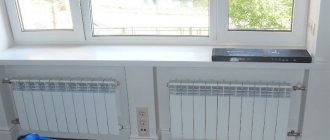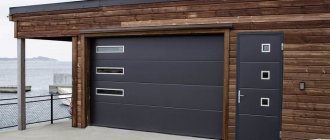Modern interior designers are trying to maximize the space in any room. To create a work space or a place to relax, a battery on the balcony will be useful. There you can make a living room, a terrace and even a greenhouse. But such repairs will require perseverance, work and courage: after all, realizing such a dream is not at all easy. Removing the battery to the balcony is an important stage of repair. This is a difficult and lengthy task, and many obstacles will arise on the way to the implementation of this project.
View from the insulated balcony Source dekormyhome.ru/
Main obstacles
Many doubt their choice and want to find out whether it is possible to place the battery on the balcony without legal consequences. This cannot be done, even if absolutely necessary. Unauthorized movement is illegal and is subject to fines. There are very good and significant reasons for this, knowing which, you want to refuse such a risky repair.
Causes:
- Risk of flooding neighbors below. The heating radiator may freeze and burst, then boiling water will flood everyone who lives below. Even a pre-insulated balcony will not save you from this.
- Extra load on the central heating system. This is an extremely complex system that requires careful handling and strict adherence to operating conditions. If you add another balcony radiator to the already working radiators, the pressure of hot water in them will weaken. Then they won't be able to heat as well as before, so the whole house will become cold.
- Difficulties during the sale of an apartment. It is imperative to show the buyer documents indicating all the parameters, including the layout of the housing and the thermal circuit. After a major renovation, the heating circuit changes, then the apartment owner will have to make repairs again and remove the excess radiator. Therefore, you need to obtain permission for redevelopment in advance or not start it at all.
- The increased cost (due to the fact that heating will have to be stronger due to the cooling of the system) will be paid by all residents of the house, and not just the initiator of the repair. You need to understand how utility bills are calculated: the total total area is divided by the number of residents of the house. Moving the battery will lead to prices rising, and not only the initiator of the redevelopment will have to pay, but also all other people.
For these reasons, placing the battery on the balcony is prohibited by law. You need to take care of yourself and those around you and insulate the loggia using alternative methods - using high-quality heaters and floor insulation.
Illegal transfer of batteries to the balcony is prohibited Source okna-dom.net
Why is it difficult to get permission?
Obtaining permission to install a central heating radiator on a balcony or loggia is difficult for a number of reasons.
Firstly, the central water supply system is designed for a strictly defined number of heating devices (radiators), which is indicated in the technical passport of the house. Therefore, a battery on the balcony means the installation of an additional heating device (radiator) entails a decrease in pressure in the coolant system and, as a result, a decrease in its temperature proportionally in all apartments.
Secondly, neither balconies nor loggias belong to residential premises, and heating of a loggia or balcony is not provided for by any technical standards. Even the most thorough insulation of these external structures does not guarantee that heating radiators installed on them with your own hands will not defrost when lowered and the heat supply to the entire house will not stop.
Thirdly, payment for heating utilities is charged based on the technical passport of the apartment, which specifies the number of radiators installed in it. Installing additional radiators is essentially theft of heat energy from the service organization, just like using electricity or water supply by bypassing existing individual meters. Even if you somehow manage to bring them onto the balcony, having received such a “permission,” it will still require changes to all the technical documentation of the apartment building, which you will have to pay at your own expense.
It will also be necessary to make an additional payment for the amount of heat received from the heating radiator placed on the balcony.
Difficulties
Knowing the laws, the owner of the apartment will understand why it is impossible to transfer batteries to the loggia. These places are not intended for living, so they are not heated. You can't do any redevelopment there, you can't radically change anything. But subject to a number of conditions and strict restrictions, it is still possible to move it. Achieving this goal and making accurate calculations will require a lot of time, money and effort. Therefore, it is best to insulate the floor and install a heater. This is much simpler, cheaper and safer; such repairs do not need to be coordinated with anyone.
Before remodeling, you need to close all the cracks. If all insulation work is not carried out efficiently, the heating effect will be minimal.
Layout of batteries on the loggia Source mastergrad.com
Let's sum it up
To transfer radiators to the loggia, you must obtain permission from the relevant authorities. This may take quite a long time. Therefore, in most cases it makes sense to consider other options: warm floors, ceiling infrared heating. Such systems are no less effective, and installation does not require approvals.
Sources
- https://tgorlovka.com/2020/07/30/mozhno-li-samostoyatelno-i-bez-soglasovaniya-perenosit-batarei-v-kvartire/
- https://fanera-info.ru/sovety-dlya-doma/nuzhno-li-razreshenie-na-perenos-batarey
- https://VseOBalkonah.ru/lodzhiya/perenos-batarei-na-lodzhiyu.html
- https://okna-dom.net/pernos-batarei-na-lodjiyu/
- https://GSPS.ru/nuzhno-li-soglasovyvat-perenos-batarei.php
- https://apb1.ru/nuzhno-li-soglasovyvat-perenos-batarei.html
- https://zonabalkona.ru/remont-otdelka/batarei-na-balkone.html
- https://TeploRes.ru/montazh-i-remont/kak-vyvesti-batareyu-na-lodzhiyu.html
How do you like the article?
Sergey Vladimirovich
Ask a Question
What to do?
Comfortable renovations and original interior design can be done with the simplest things. Instead of a battery, it is much easier to place a heater on the balcony by choosing a convenient model. There are now various types of home heaters on the market. Old equipment spent a lot of electricity, but now infrared heaters have appeared:
- ceiling;
- wall;
- floor
They spend little energy, but warm the room perfectly and can automatically turn off when warm.
Two batteries on a closed loggia Source www.isstone.net
How to warm
To solve the question of how to heat a balcony, you should use the simplest heating methods:
- Installation of electric oil heaters or convectors . Allows you to heat quickly and quietly. They waste a lot of electricity to maintain heat, high-quality installation of the electrical network is required, and the air becomes very dry;
- Infrared heaters allow you to warm up objects, ceilings, and walls. They are usually installed under the facing material, so they release heat and transfer it to the materials, providing heating to the room and without drying out the air. The operation of the heater has a positive effect on the body and is useful for diseases of the human cardiac and vascular systems. Consumes electricity, heating a large area requires a large heater area, fire hazard, plastic elements of walls and ceilings can be deformed;
- Electric “warm floors” – The balcony is heated by a cable laid in the form of a snake under the decorative floor. Allows you to regulate the temperature, uniform heating of the area. Warming up requires a long time, energy consumption, installation complexity and installation of floor finishing material. Materials that do not release harmful substances when heated should be used.
Also read on our website: Insulating the ceiling of a balcony or loggia
The use of any of the listed systems for heating is possible provided that the room is well insulated, otherwise heating will not work.
Moving the battery to the balcony without violating the law
Installing a heating element on a balcony can be done quite legally, but in this case you need to be prepared for certain difficulties and inconveniences. The first thing that will be required of you is the exact parameters:
- temperature;
- how many sections need to be installed;
- section dimensions;
- future localization of heating sections;
- pressure in pipes.
An amateur will not be able to correctly carry out accurate calculations, so you need to turn to professional designers. Their services are quite expensive, so you will have to spend a significant amount.
Then they must write an application with a corresponding request to transfer the heating element to the housing and communal services inspection. They will require:
- results of accurate calculations;
- from experts - official confirmation that the risk of water freezing in the radiator is minimized;
- signed redevelopment project (from professionals);
- calculation of thermal conductivity.
The housing inspection has the right to require additional documents, for example, an apartment registration certificate. The list of documents may vary depending on the specific legislation of the region.
Two radiators on the loggia Source sofos-okna.ru
The housing inspectorate gives permission within several months. There is a high chance of getting rejected. Therefore, you should never get down to business until this permission has been received. This is a violation of the law, for which you can be fined.
While the documents are being approved, you can insulate the balcony. Without this, moving the radiator is pointless and dangerous. In addition, the lack of insulation will not allow you to prove that the permissible temperature is maintained on the loggia.
To achieve his goal, the apartment owner must perform several actions.
- Make accurate calculations.
- Report to the housing inspectorate.
- Carry out total and high-quality insulation of the room.
You cannot carry out work first and then seek permission. You cannot do illegal redevelopment: sooner or later the neighbors and the housing inspector will find out about it, and then you will have to pay a fine.
Radiator on the balcony Source royal-comfort.ru
Connection to the heating system
The insertion into the central heating riser must be done not only technically competently, but also in such a way that it is unnoticeable to the neighbors. Or, at least, so that their living conditions do not deteriorate so much that they seek legal protection. How to do it?
Battery placed on the balcony
Insertion methods
There are two ways to connect to a hydraulic system: series and parallel. A parallel method is described in the simplest words on one of the construction and repair forums:
With the sequential method, the insertion is carried out at the outlet of the donor battery, and after the additional battery is energized, the pipe extending from it is connected to the “cold” part of the donor battery.
Pros and cons of two types of connections
Connection in parallel with a steam heating radiator behind the wall
With a parallel connection, the cross-section of the water flow into your apartment increases. Exactly the area of the hole through which you supply water to the additional battery. How critical is this?
Let's say you live in a five-story building. The thermal riser lifts hot water from the basement through the radiators of five apartments to the top floor and with its other branch lowers it down through five other radiators.
Thus, there are 10 batteries sitting on one riser, your additional one will be the 11th. The cross-section of the watercourse will increase by 10%, and the pressure will drop accordingly; it will not be difficult to record such a noticeable value by simply observing the pressure gauge. If your neighbors have complaints against you, then legal disputes cannot be avoided.
Then the parallel watercourse must be shut off, the water from the branch must be drained, and the balcony must be used as an unheated room during frosts. This is the lesser of two evils.
Anything more - bursting pipes will cost a pretty penny.
When an additional heating circuit is connected in series, the total cross-section of the water flow does not increase, the pressure in the system does not drop, but this does not mean that the temperature in the neighbors’ apartments will not drop: after all, you are heating your balcony, the coolant loses its calories in this area, and no matter how scanty these losses may seem like they may be the drop that overflows the capacity of your home’s thermal communications to bear the load.
If the facade wall is preserved, hang the battery on it!
It is impossible to turn off the serial connection with one turn of the valve: you will block either the entire riser or a significant part of the circuit connected to it (depending on the overall design of the heating system).
Another useful tip: if your balcony is not combined with a room, then mount the battery on the wall on the outside of the facade wall.
Laws
Before interfering with construction and communication systems, you should carefully read the Housing Code of the Russian Federation:
- Art. 15, paragraph 5 - here are the conditions that make it possible to recognize that the premises are intended for living. Based on this article, you need to prove to the housing inspectorate that the loggia will also become a living room after renovation.
- Art. 25, paragraph 1 - heating and other utilities can be transferred, but only in living rooms, to which the loggia does not belong.
These parts of the law will allow legal redevelopment to be granted, subject to a number of strict conditions being met.
Transfer procedure
You can get permission to install a battery if you are extremely motivated, have strong nerves and free time to visit various authorities. It all starts with collecting a package of documents that will be required in the future.
It consists of:
- technical passport of the apartment with a floor plan (certificates in form f.1a and f.5) which is issued in the BTI;
- a redevelopment project prepared by a licensed design organization;
- technical conclusion on the possibility of redevelopment without damaging the entire heating system of the house;
- conclusion of the Ministry of Emergency Situations (fire service) on the admissibility of such redevelopment;
- conclusion of the SES (Rospotrebnadzor) on the possibility of redevelopment;
- coordination with the design architectural organization that developed the house project;
- consent of the homeowners in the house to change common property;
- consent of the apartment owners;
- copies of the document (notarized) on ownership;
- permission from the organization servicing the house (REU, HOA, DEZ, UK) to carry out work;
- agreement with a licensed organization on technical supervision of the work procedure.
At the same time, any of the listed organizations may request documents confirming the feasibility of transferring the balcony to a residential premises.
The licensing authority does not require any additional motivation to refuse to issue such a permit.
A direct ban on the installation of central heating batteries is contained in the Housing Code.
And this is enough for you to be refused.
Punishment
Illegally removing the battery onto the loggia puts all residents of the house at risk and creates a number of difficulties for them. There is a penalty for unauthorized redevelopment. In 2022, individuals will pay a fine of 2,500 rubles, and legal entities - 70 thousand rubles.
In addition to paying a fine, the violator will have to remove the radiator from the balcony at his own expense and restore everything to its original condition. This decision can be challenged, but you will have to prove that the repairs will not harm anyone. You will need a conclusion from specialists and the signatures of all residents of the house.
Balcony after renovation Source proffstroygroup.ru
Package of documents required for approval
First of all, you need to prepare a project specifying the types of equipment and installation locations.
The technical report must indicate the location of heating devices.
Important to note:
- for a thermal engineering calculation proving that heat losses will not increase as a result of the redevelopment;
- to maintain access to heating risers.
A written appeal is submitted in the prescribed form through the MFC or during a personal visit, attaching:
- the original or a notarized copy of the document confirming ownership of the apartment - purchase and sale agreement, exchange, donation, will;
- compliant refurbishment project;
- registration certificate for the apartment;
- written consent to the relocation of all adult family members living with the applicant at the specified address.
After completing the installation of the battery at a new location, a commission is invited to sign an acceptance certificate, which serves as the basis for making changes to the technical passport.
Types of batteries
After approval, you need to purchase suitable batteries. Their choice must be approached responsibly. To do this, you need to have a good understanding of their varieties and features.
There are three classes of radiators, which differ from each other in materials and their quality:
- Economy - cast iron, steel.
- Middle - bimetal, aluminum, tubular steel.
- Premium - made from the same materials, but improved, cast, designer.
Materials vary in quality and service life. You need to immediately choose the appropriate option.
Types of radiator for a loggia:
- Cast iron takes a long time to heat up and cools down slowly. They serve for 35 years, longer than all other types.
- Aluminum - have high thermal conductivity, heat up quickly, and weigh little. They serve for 15–20 years. But they can deteriorate due to the fact that the liquid inside the pipes has an inappropriate pH. Aluminum radiators are only suitable for an autonomous heating system, for example, in a private house.
- Steel panels are of high quality, have excellent heat dissipation, and are inexpensive. Service life - 15 years.
- Tubular steel - high quality and durable. In stores you can find a variety of design solutions for any interior. Expensive. They serve properly for about 15 years.
- Bimetallic - have a pipe frame on which an aluminum “jacket” is located. This is a prefabricated structure that may leak. You need to choose a model in which only steel parts are in contact with water, and aluminum serves as the outer covering. There is a way to check the quality of a bimetallic battery: you need to run a magnet over it. If the magnet sticks to the horizontal and vertical parts, then the battery is of high quality. If it does not stick to these parts, then there is no steel inside it. Bimetallic radiators are resistant to water hammer, mechanical damage and coolant water. This is the best option for any apartments and houses. They serve for 25–30 years.
Knowing the features of all types of radiators, you can make the right choice and install the appropriate model.
Bottom, side, diagonal arrangement and connection of pipes Source learnmech.com
Choosing a radiator
When the procedure for obtaining permission has been successfully completed, it is time to choose a room heating element that is suitable for the loggia.
All batteries are divided into 3 types:
- economy segment;
- middle class;
- premium
The main criteria for differences are cost, quality of materials and duration of operation.
Cast iron
The best and most durable metal of all times has been and remains cast iron. The shelf life of such radiators is more than 35 years. They are stronger than analogs made from other materials, but they weigh a lot. It is recommended to install it on the loggia only from the side of the house wall. The balcony can support no more than 600 kg of weight.
There is no need to additionally load it, because there is an installed double-glazed window, finishing, tiles on the floor (or other covering), and furniture. They look quite massive and the classic look does not always fit into a modern interior.
Aluminum
They weigh much less, are made in a modern design, and conduct heat well. The only negative: they can rust and deteriorate if the water they receive is of poor quality. Recommended for private homes where the source of water is known and autonomous.
Bimetal
Radiators of this type are most often used in apartment buildings. Bimetallic structures are compact and look laconic. They come in different sizes, conduct and release heat well. Ideal for a balcony or loggia due to its light weight and versatility in installation.
How to calculate the number of sections
There are standards that will allow you to make accurate calculations and indicate how many sections are needed to maintain warm weather indoors. The following conditions must be met:
- for 1.5 m2 - 1 part made of bimetal;
- for 2 m2 - 1 part made of aluminum;
- spare 1-2 parts.
All batteries are assembled from parts, so you need to know exactly the number of sections.
Scheme for moving a radiator to a balcony Source mastergrad.com
Alternative options for insulating a loggia
A battery on a balcony is a dangerous undertaking that will require a lot of effort and time. And this idea may end unsuccessfully. Thanks to modern technologies, it is possible to insulate a loggia using alternative methods.
In terms of heating quality, they are in no way inferior to the classics, and some even surpass them:
- The heater is an outdated, but reliable and economical method. The time for outdated air cannons and similar devices is over. Now heaters are made using infrared film. This significantly reduces energy consumption. Read more in the article “balcony heating”.
- Warm floor. An excellent replacement for the general heating system not only on the balcony, but throughout the entire apartment. Does not take up space, heats the entire area evenly. You can adjust the temperature yourself. Installation is not complicated, it does not consume much electricity, and the overall cost will be lower than paying for central heating. Disadvantage: installation will cost more than a radiator. But you can do the installation work yourself and reduce the cost.
Read in detail in the article “Warm floor on the loggia“.
And if you combine two alternative methods, the loggia will maintain a comfortable temperature even on the coldest days.
The owner can use the property at his own discretion. However, the constitutional rights of citizens living nearby must be respected. Moving a radiator to a balcony is a dangerous undertaking and permission for it is not easy to obtain. New buildings have an advantage; Soviet-built houses rarely receive the necessary confirmation. It is better to entrust the installation to professionals so as not to damage the overall communications system.
Connection options
It is very important to choose the right option for the location of the radiator pipes on the balcony. There are several types:
- Bottom - both heating pipes are located at the bottom of the battery. The inlet pipe is placed on one side, and the outlet pipe on the opposite side. In order for the radiator to heat up well and give off heat, you need to leave a sufficient distance between the fittings.
- Lateral - on one side of the battery there are inlet and outlet pipes. It is important that there is a large distance between the fittings so that the radiator heats up effectively.
- Diagonal - the inlet pipe is located on top of one half of the radiator, and the outlet pipe is located below on the other half. The best option because it provides the least heat loss.
It is necessary to remember the conditions of the loggia and choose the appropriate connection option:
- There is a tap and a jumper - the coolant evenly heats the pipes without heat loss. The best option.
- Only with a jumper - if it gets too hot, you can easily block the flow of boiling water into the pipes.
- Only with a tap - allows you to shut off the flow of coolant and temporarily remove the battery for repairs.
These options will allow you to regulate the degree of heating of the battery on the balcony.
What to consider when choosing a heater
To choose the right heater for your balcony, you should consider the following technical features:
Device power. The rate of heating of the air in the room depends on it
Homeowners need to remember that powerful appliances require careful handling; they cannot be connected to a network with a TV, washing machine and other similar equipment; they consume a lot of electricity. If you do not have the ability to connect them, take simpler analogues. Device mounting options
Before ordering convectors or a “warm floor” system, think about whether you can install and connect it correctly. If not, it is advisable to choose a simpler option for electric heaters: an infrared lamp, a fan heater. Functional features of the room. If you need to heat your balcony for a couple of days in winter, there is no point in installing expensive heating equipment on it; a regular fan heater will be enough. If the balcony is used as a separate room, it is better to install a “warm floor” system or convectors on it. Work safety. Do not use high-heat appliances if you have inquisitive pets or small children. In such cases, it is better to choose the safest options: infrared heaters or a “warm floor” system.
If you cannot decide which heating equipment to use for your balcony, contact a specialist on this issue. They will take into account all the operating features of this premises and select the most suitable option taking into account your budget.
Installation Rules
All work on moving the battery to the loggia should be carried out only by highly qualified professionals, masters of their craft. This is an extremely difficult job: one wrong move and the whole house will suffer. All connecting nodes must be perfectly sealed. The owner of the apartment will have to order services from specialists. But no professional craftsman will perform such work if the owner does not have official permission to remove the battery to the balcony.
It is advisable to carry out this work in the summer, when there is no heating. Moving a heating radiator to a balcony is extremely undesirable and dangerous during the heating season. You will have to turn off the heating in the entire house. Such a permit costs money and the neighbors will not like it. In addition, you will need to shut off the riser at the appointed time, and this will deprive all neighbors of heat.
Radiator on the balcony near the wall Source sofos-okna.ru
Sequencing
It is necessary to thoroughly insulate and install double glazed windows!
So, the legal and technically correct sequence of actions if you want to place a heating radiator on the balcony consists of the following steps:
- insulation of external walls;
- coordination of redevelopment, obtaining relevant permits and conclusions;
- choosing the optimal type of radiator and installation method;
- wall preparation - installation of thermal insulation, finishing;
- direct installation.
If you are firm in your intentions, then for apartment buildings it is recommended to move the radiator from the room to the balcony, and not to install an additional one, which will immediately significantly reduce the efficiency of the general building system - this is unlikely to please the neighbors and will entail inspections.
Requirements
There are a number of strict requirements that must be met in order to achieve excellent heat transfer:
- you need to retreat at least 2–3 cm from the wall;
- place the supply pipes at a slope of 5–10 mm per linear meter;
- 10–12 cm from the window sill;
- 12–14 cm from the floor;
- the battery is placed evenly in all directions (use a level);
- the window sill covers the battery;
- to regulate the temperature on the loggia and the supply of coolant water, you need to make a jumper with a ball valve;
- You cannot bend the pipes too much or too often: these bends cause air pockets that block the supply of boiling water and have a bad effect on the operation of the entire heating system as a whole.
To comply with all these requirements, it is necessary to check each action using a tape measure, ruler and level. It is advisable to attach a screen wrapped in foil to the wall to better retain heat. The foil will glow and direct warmed air into the room.
Heated balcony floor Source kapiteltk.ru
Water heated floor heating loggia
How to heat a loggia? You can install a modern system with the established name warm floor. The options include both electric heated floors and water heated floors. Very often the choice leans towards the second option.
Water floor installation:
- First, a concrete screed is laid;
- Then the concrete screed is leveled;
- Then the insulating material is laid;
- Then plastic pipes are laid, the basis of the heated floor system, the pipes are laid in a snake pattern, at a relatively short distance from the bends;
- Plastic pipes are connected to the hot water supply system;
- Then the concrete screed is laid again.
Heating is carried out using hot water. The disadvantage of this method is that the process is labor intensive. The same electric heated floor will be easier to install.
How to install a battery on the balcony
After receiving the documents and concluding an agreement with the craftsmen, you can begin work. To move the battery to the loggia/balcony you will need a lot of professional equipment.
What you will need for work:
- battery;
- reinforced polypropylene pipes;
- level;
- brackets;
- Bulgarian;
- drill;
- all the necessary details;
- Mayevsky crane,
- roulette;
- soldering iron or welding device.
Ceiling, wall, floor infrared heaters Source nikotools.kz
How to install the battery on the balcony:
- Remove the old radiator.
- The pipes in the room from which the radiator is being removed must be cut - 10 cm from the place where the battery is connected.
- Use a drill to drill holes in the wall with a diameter of 2 cm. Pipes connecting the riser and the battery will pass through them.
- Cut threads on pipes.
- Pull the pipes through the holes so that they extend 8–10 cm into the room.
- Mount all the elements: first the roll, then the connections, fittings, and then the riser. All parts must fit in size and have threads.
Balcony with a single battery Source urs-ufa.ru
- Connect the pipes using a waterproofing agent (fum tape or tow).
- Place the radiator against the wall and use a level to mark the places where the fasteners will be installed.
- Attach the battery to three brackets. The first is located at the top, the remaining two are at the bottom. It is better to secure a massive battery on 4 brackets.
- Connect the Mayevsky tap, adjust other taps and plugs.
- Check the tightness of the entire structure.
- Connect the pipes.
It is advisable to entrust these works to professional craftsmen with experience and qualifications. It is dangerous to do such complex repairs with your own hands: any mistake can be fatal.
How to choose an IFC heater for a terrace
Infrared electric patio or balcony heaters emit a targeted heat beam that is immediately felt by people within its range. Consequently, heating a terrace using such devices is more efficient, more economical and safer than gas heating.
What to look for when purchasing
- When choosing a patio heater, the first thing you need to do is check the materials it was made from and whether it is waterproof.
- In addition, it is necessary to check the water resistance rating with protection against water splashes from any angle.
- The housing should preferably be made of stainless steel or aluminum with an anti-corrosion coating.
- Choose all-weather IFC heaters.
Not sure what heater wattage you should choose for your patio? Here are some tips for choosing a radiator.
How many meters of terrace do you want to heat?
Remember that it is usually not necessary to fully heat your deck. Here's why it doesn't matter how big your terrace is
What is more important is which dedicated area on the terrace (surface) you want to heat. Think about where you usually stay: a sofa, a table with chairs? For example: if this is a table area and your entire terrace has an area of 50 sq.
M, then it is enough to heat about 10 square meters. M terrace area. Because the surface of a table with chairs rarely takes up more than 9 m2.
If permission is received
If you are an extremely lucky person, you can bypass all bureaucratic obstacles, secure the consent of all residents of the house and obtain the coveted permission or win the case in court. Then you can think about how to install a balcony heating system.
To do this, you will need to calculate the floor area on the balcony, since, based on this value, you will need to calculate the number of sections in the radiator.
This is done simply. But according to SanPiN standards, for heating 1 m2 of living space, 2 sections of heating radiator are used if they are made of aluminum or 1.5 if bimetallic radiator sections are used. You can divide the balcony area by 2 or 1.5 and you will know what size battery you need to install.
Currently, aluminum radiators are the most popular. They provide great heat transfer and are quite easy to install.
In addition to the heating radiator itself, you will need to purchase a number of fittings and pipes, as well as brackets for attaching the battery to the wall. Battery installation work is MANDATORY. carried out by a plumber from an organization that services the utilities of your home. If you install it yourself, you risk violating the technology; then the existing permit to install a heating radiator in a balcony recognized as a residential area will not save you.
The only thing you can do during the work is to ensure that the installation is correct. To do this, it is useful to know that to attach the radiator to the wall of the balcony, at least 3 brackets must be used, on which the battery sections are hung. Two brackets should be located at the top - they bear the main load and one at the bottom - it limits the mobility of the battery.
The distance from the top edge of the battery to the window sill is at least 100 mm, and the distance from the floor of the balcony is at least 120 mm. The radiator distance from the wall should be more than 20 mm. Before installing the radiator, you can install a reflective screen made of foil heat insulator (penofol) on the wall so as not to warm up the wall of the house. It is most advisable to use metal-plastic pipes, which are easy to install and do not require welding. This way you will protect the interior and cladding material on the balcony from damage by hot scale generated during welding, and you will not have the risk of a fire.
Pipes connected to the radiator must not have kinks. Otherwise, an air lock may form and your battery will be cold. Also, if the radiator size is more than 12 sections, it is advisable to use a diagonal connection scheme, otherwise the coolant will stagnate in the outer sections and they will be cold.
After installation is completed, the work must be accepted by a commission consisting of employees of the service organization and the housing inspection.
Based on the results, an act will be drawn up that will serve as the basis for making changes to the technical passport prepared by the BTI.
At the same time, the area of the residential premises will change and you will have to issue a new passport, and after that, receive a new certificate of ownership of the residential premises, taking into account the changed area.
Installation options for a balcony battery
To remove the radiator of the heating system, you will have to use one of two technologies for connecting to the existing wiring:
- Sequential removal - pipes are connected to the ends of the room radiator, after which they can be taken out to the balcony.
- Parallel removal - pipes cut into the supply and return channels, they are also led out to the installed battery.
If you route the pipes according to the first scheme, you will need to connect the upper ends of the old and new heat exchanger with one line, and then repeat these steps with the lower ends. Before installation, the side plugs are removed from the old battery, so work is carried out in the summer or spring, when the water has been drained from the central wiring.
If you want to remove pipes according to the second (parallel) scheme, you will need to cut a tee into both the supply channel and the return of the central heating system. After this, install the pre-purchased radiator on the balcony and connect its upper pipe to the supply line tee. A pipeline is connected to the lower branch pipe, stretched to the return tee.
The installation of heating devices and the arrangement of tie-in points into the pressure and return lines are carried out by the utility workers themselves or by specialized companies. If you dare to take the heat exchanger out onto the balcony yourself, you will have to be responsible for all the mistakes and miscalculations made in the event of flooding of your neighbors.











